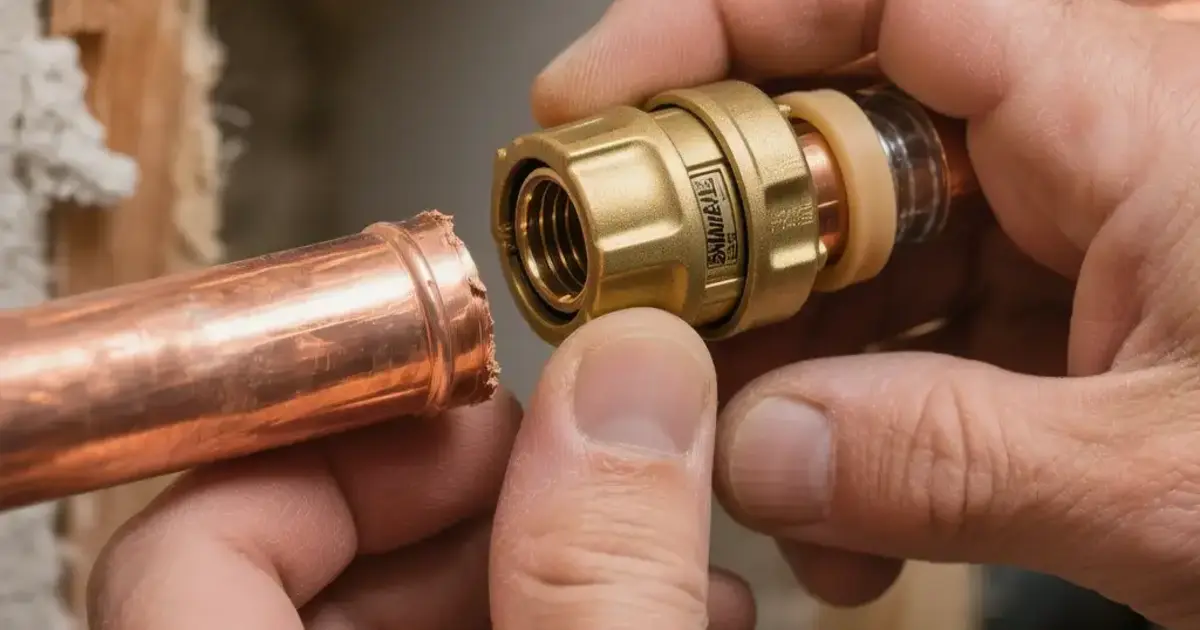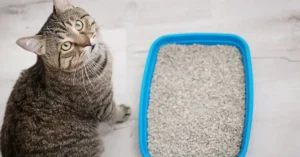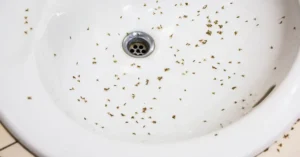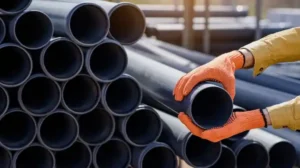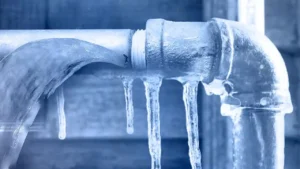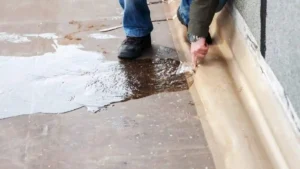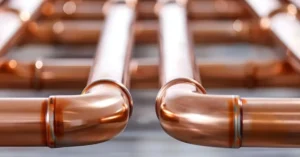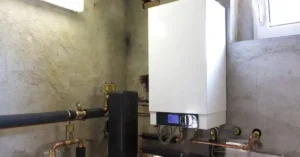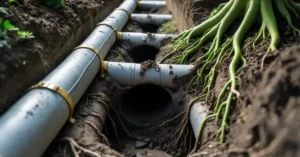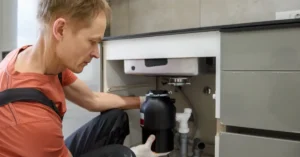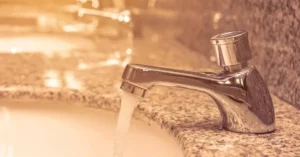SharkBite fittings have changed the plumbing game for homeowners and professionals alike. These push-to-connect fittings let you join copper pipes without soldering, brazing, or special tools. You simply push the fitting onto the pipe, and internal teeth grip it tight while an O-ring seals the connection.
Learning how to install SharkBite on copper takes just minutes. The process involves cutting your pipe clean, deburring the edge, marking the depth, and pushing the fitting straight on. This guide walks you through every step with real examples and pro tips that ensure leak-free connections every time.
Tools & Materials Needed for SharkBite Installation on Copper
Getting the right tools makes sharkbite installation copper quick and easy. You don’t need a torch or expensive equipment.
Essential Tools:
- Pipe cutter (not a hacksaw)
- Deburring tool or emery cloth
- Permanent marker
- Measuring tape
- SharkBite disconnect clip (for future removal)
Materials Required:
- SharkBite fittings (couplings, elbows, tees, or valves)
- Copper pipe (Type K, L, or M)
- Clean cloth or paper towels
Choose the right size fitting for your pipe. SharkBite fittings come in ½-inch, ¾-inch, and 1-inch sizes for most home plumbing jobs. Always check that your copper pipe diameter matches the fitting size before starting.
Step-by-Step: How to Install SharkBite on Copper
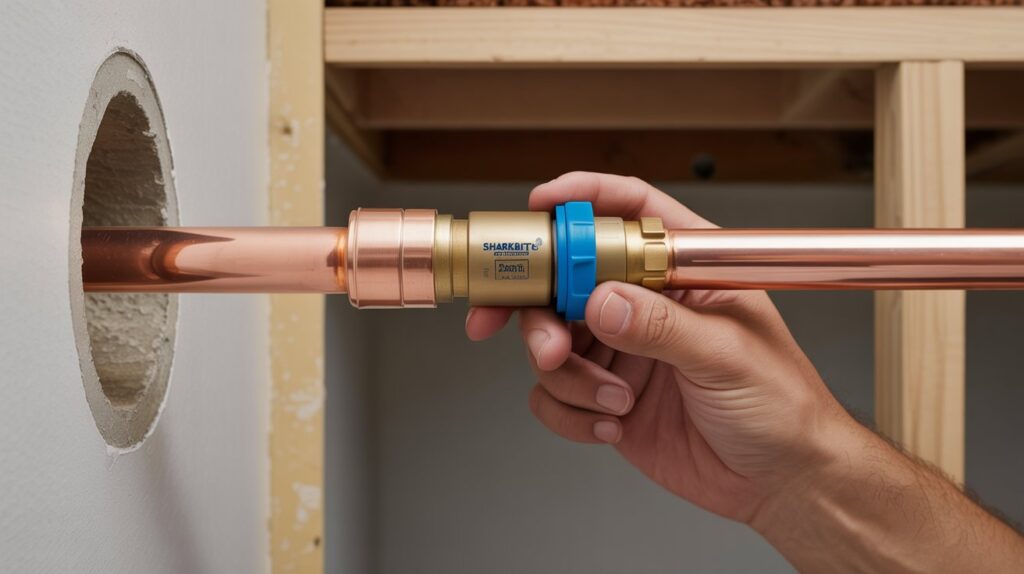
Installing sharkbite on copper requires precision but not perfection. Follow these steps for a solid connection.
Step 1: Cut the Copper Pipe Clean
Use a proper pipe cutter, not a hacksaw. Hacksaws leave rough, angled cuts that prevent good seals. Place the cutter blade on your mark, tighten the knob, and rotate the tool around the pipe. Tighten slightly after each rotation until the pipe separates.
Check your cut. It should be perfectly square to the pipe, not angled. An angled cut creates gaps where water can leak past the O-ring.
Step 2: Deburr and Clean the Pipe End
Cutting creates a raised edge or burr inside the pipe. This burr can damage the O-ring during installation. Use a deburring tool to remove it. Insert the cone-shaped tool into the pipe and twist a few times.
Clean the outside too. Use emery cloth or sandpaper to remove any oxidation, dirt, or old solder. The pipe should be bright and shiny for about 1 inch from the end. Wipe it clean with a dry cloth.
Step 3: Mark the Insertion Depth
Each fitting requires a specific insertion depth. Check the SharkBite depth chart or measure from the fitting itself. Most ½-inch fittings need 0.95 inches, while ¾-inch needs 1.10 inches.
Use a permanent marker to make a clear line around the pipe at this depth. This mark shows you when the pipe is fully inserted.
Step 4: Push the Fitting Straight On
Hold the fitting square to the pipe. Push firmly and steadily until the pipe reaches your depth mark. You’ll feel resistance as the grab ring engages. Keep pushing until the mark disappears inside the fitting.
Don’t twist while pushing. Twisting can damage the O-ring or misalign the grab ring. Push straight and firm in one motion.
Step 5: Verify the Connection
Tug on the fitting to test the grab ring. It should hold tight with no movement. Look for your depth mark. If you can still see it, the pipe isn’t fully inserted.
Turn on the water slowly and check for leaks. Watch the connection for a few minutes. A proper installation won’t drip at all.
How to Install a SharkBite Elbow on Copper
Elbows let you change pipe direction without complex cuts or joints. Installing a sharkbite elbow follows the same basic steps with one key difference.
Plan Your Angle First
Measure twice before cutting. You need to know exactly where both pipe ends will be. An elbow fitting adds its own length to the connection. Most 90-degree elbows add about 1.5 to 2 inches to your total pipe length.
Cut both pipes square and deburr them. Mark the insertion depth on each end.
Install One Side, Then the Other
Push the elbow onto the first pipe end. Make sure it reaches the depth mark. Check the elbow angle before connecting the second pipe. The outlet should point exactly where your second pipe will go.
Hold the elbow steady and push the second pipe in. This can be tricky in tight spaces. You might need to flex the pipe slightly to align it.
Support Long Runs
Any pipe longer than 3 feet needs support. Install pipe clamps or hangers within 12 inches of the elbow fitting. This prevents stress on the connection from pipe weight or water hammer.
Tips for Leak-Free SharkBite Copper Connections
Using sharkbite on copper works great when you follow best practices. These tips come from real plumbing experience.
Always Use New Fittings for Permanent Repairs
You can reuse SharkBite fittings, but don’t do it for permanent work. The O-ring compresses during the first installation. While it may seal again, the risk of leaks increases. Save old fittings for temporary repairs or testing.
Temperature Matters
Install sharkbite on copper at room temperature when possible. Cold pipes contract, hot pipes expand. A fitting installed on a hot pipe might leak when the pipe cools and shrinks. Let hot water lines cool for 30 minutes before working on them.
Watch Your Water Pressure
SharkBite fittings handle up to 200 PSI at 200°F. That’s more than enough for home plumbing. If your home has pressure above 80 PSI, install a pressure reducer. High pressure stresses all fittings and can cause premature failure.
Keep Pipes Straight During Installation
Don’t bend or flex the pipe while pushing on the fitting. This can cock the fitting at an angle and compromise the seal. If working in a tight spot, make your cuts longer so you have room to work straight.
Use the Right Pipe Sizes
Never force a fitting onto an oversized pipe. SharkBite fittings work only with standard copper sizes. Verify your pipe diameter with calipers if you’re unsure. European or older pipes might use different sizing.
Common Mistakes to Avoid When Installing SharkBite on Copper
Even experienced DIYers make these errors. Learn from them to save time and prevent water damage.
Mistake 1: Skipping the Deburring Step
That sharp edge inside a fresh cut will slice your O-ring. The leak might not appear right away, but it will happen. Always deburr both the inside and outside of the pipe.
Mistake 2: Not Cleaning Oxidized Copper
Green or black oxidation prevents the grab ring from biting properly. The fitting might seem tight but can pull off under pressure. Spend 30 seconds cleaning the pipe. It’s worth it.
Mistake 3: Using Damaged Fittings
Dropped fittings can have bent grab rings or nicked O-rings. Inspect each fitting before installation. Look for dents, cracks, or dirt inside. If you see damage, use a different fitting.
Mistake 4: Forgetting to Mark the Depth
You can’t tell if a pipe is fully inserted without a mark. Partial insertion is the top cause of leaks. Make that mark every single time.
Mistake 5: Installing in Walls Without Access Panels
Sharkbite to copper pipe connections work great for accessible locations. Don’t bury them in walls without an access panel. While failures are rare, having access makes future repairs possible. Code requirements vary by location, so check local rules.
Mistake 6: Over-Tightening or Using Tools
SharkBite fittings are push-to-connect only. Don’t use wrenches or pliers. You can’t make them “tighter” with tools. You’ll only damage the fitting body. Hand pressure is all you need.
You can read about: How to Fix Pinhole in Copper Pipe
Conclusion
SharkBite fittings offer a quick and dependable solution for connecting copper pipes without the need for soldering or special tools. To ensure a secure fit, start by cutting the pipe cleanly, deburring the edges, cleaning the surface, marking the insertion depth, and pushing the fitting straight onto the pipe. When done correctly, these connections can last for decades.
For more complicated plumbing repairs or expert assistance with copper pipe repair Eagle Rock, reach out to Derks Plumbing. Our skilled team specializes in everything from simple SharkBite installations to complete repiping projects, ensuring lasting quality and performance.
FAQs
Can SharkBite fittings be used on all types of copper pipe?
Yes, SharkBite fittings work with Type K, L, and M copper pipes. These cover all standard residential and commercial copper plumbing. Avoid using them on soft copper coils without proper pipe support.
Do I need to turn off the water before installing SharkBite fittings?
Always turn off water before cutting pipes or installing fittings. Attempting installation on pressurized pipes creates dangerous situations and prevents proper seating.
How long do SharkBite fittings last on copper pipes?
Properly installed SharkBite fittings last 25+ years. Many installations from the early 2000s still perform perfectly. Quality installation is the key to longevity.
Can SharkBite fittings be hidden behind walls?
Local codes vary. Some areas allow SharkBite fittings in walls with proper access panels. Others require soldered joints for concealed locations. Always check your local plumbing code before hiding any connection.
What’s the most common reason SharkBite fittings leak?
Incomplete insertion causes most leaks. The pipe must reach full depth for the grab ring and O-ring to work properly. Always mark your depth and verify the mark disappears inside the fitting.

